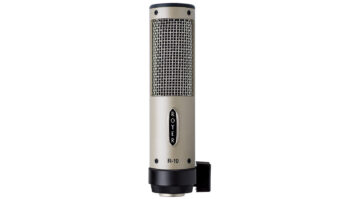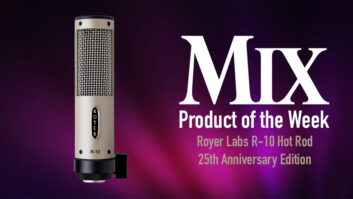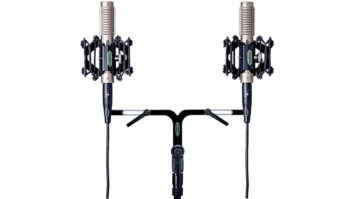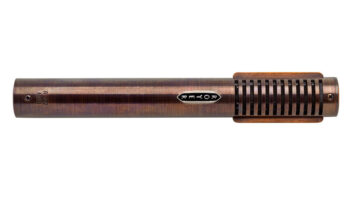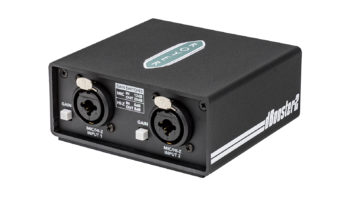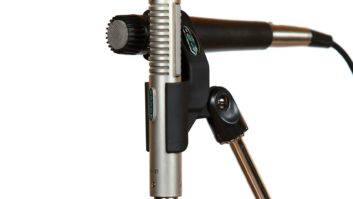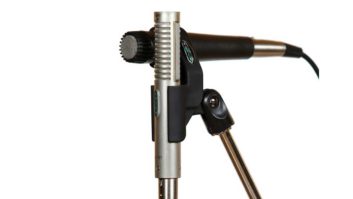
ROYER LABS LIVE SERIES
November 2007—Until now, taking expensive ribbon mics on the road has always been a scary proposition. Royer (www.royerlabs.com) has released rugged, road-ready versions of its SF-24 phantom-powered stereo ribbon microphone, the R-121 ribbon microphone and the R-122 active ribbon microphone. These mics are road-worthy thanks to more robust ribbons: On the SF-24, the thickness of the two ribbons has been increased from 1.8 microns to 2.5 microns, while on the R-121 Live and R-122 Live models ribbon thickness has been increased from 2.5 microns to 4 microns. Live Series microphones are identified with an “L” on the top of the mic and are priced the same as the studio versions.
ROYER SF-12
February 2007—Offered in matte-black chrome and satin-nickel finishes, Royer Labs’ SF-12 ($2,150) is housed in an ingot iron case that forms part of the magnetic return circuit. Its two matched 1.8-micron, aluminum-ribbon, figure-8 transducers are placed one above the other, each aimed 45 degrees off-axis from center in the Blumlein configuration. Both capsules can provide mono recording, and two channels can be combined for mono recording without creating phase artifacts. The SF-12’s response is 30 to 15k Hz (±3 dB), and it handles SPL levels up to 130 dB. The SF-12’s extension cable comes with a “Y” adapter that splits into two 3-pin male XLR outputs.
ROYER SF-24
January 2007—Royer’s SF-24 ($3,800) stereo ribbon mic is optimized for Blumlein and M-S configurations, and comes in an optical black finish; 18-karat gold is optional. It shares the SF-12’s design characteristics while adding Royer’s active electronics system, allowing the SF-24 to be used with any preamplifier with average gain characteristics. The SF-24 operates on 48V phantom power and contains two fully balanced, discrete head amplifier systems using specially wound toroidal transformers. Stated response is 40 to 15k Hz (±2 dB), and max SPL handling is 130 dB. The SF-24’s output of -38 dB is 14 dB more sensitive than the non-powered SF-12. Custom-designed FETs provide quiet operation, with self-noise less than 18 dB. The SF-24’s output connector is a 5-pin male XLR.
ROYER R-122V
October 2006—Finally shipping, Royer’s (www.royerlabs.com) long-awaited first vacuum tube ribbon mic is based on the same ribbon transducer technology as the acclaimed R-121 and R-122. However, the R-122V uses a triode-driven circuit to raise the mic’s sensitivity to -29 dB. The mic is finished in 18-carat gold, and features a dedicated power supply and cable with military-grade locking-type XLR connectors, Jensen output transformer and proprietary toroidal mic transformer.
ROYER R-122V TUBE RIBBON MIC
Looking tempting in its 18-carat-gold jacket, the Royer R-122V ($3,495) features the same large-ribbon transducer assembly found in the R-121 and R-122 active ribbon microphones. The “V” ups the R-121 ante because it offers -29 dB of output, approximately 25 dB hotter than the R-121. The R-122V’s active electronics use a NOS 6AU6 vacuum tube and Royer’s proprietary toroidal ribbon-matching transformer. A Jensen 8:1 ratio output transformer provides an electrically isolated, fully balanced output signal. Because of its powered output, the R-122V can easily drive virtually any preamplifier and long cable runs (from power supply to preamp). The active circuitry provides optimum impedance to the ribbon element at all times, preventing over-damping. The R-122V employs a pure (99.99%), low-mass, 2.5-micron-thick aluminum ribbon.
ROYER R-122V TUBE RIBBON MIC
October 2005—After years of development and testing, Royer unveils its first vacuum tube ribbon mic at AES. Based on the same ribbon transducer technology as the acclaimed R-121 and R-122 (pictured), the R-122V uses a triode-driven circuit to raise the mic’s sensitivity to -29 dB. The mic is finished in 18-carat gold and features a dedicated power supply and cable set with military-grade locking-type XLR connectors, Jensen output transformer and proprietary toroidal mic transformer.
ROYER SF-1V TUBE RIBBON
March 2002—At Winter NAMM, Royer launched the $5,500 SF-1V, a
vacuum tube ribbon mic designed for choirs, orchestras or other
distance-miking situations.
ROYER ACTIVE RIBBON MICS
January 2002—At the fall 2001 AES, Royer introduced Active Ribbon
Mics, the world’s first active, phantom-powered ribbon models. Based on
Royer’s current R-121 and SF Series ribbon mics, these models feature
all-discrete, low-noise FET head amps, making them as sensitive as
condenser mics, eliminating the need for ultrahigh-gain preamps.
ROYER SF-1 RIBBON MIC
October 2000—Royer Labs introduces the SF-1 ribbon microphone,
Royer’s latest “modern ribbon,” a compact, monaural version of its
popular SF-12 stereo ribbon microphone. It uses the same ribbon
element, transducer and electronics as the SF-12 and was built to
satisfy engineers who like the sonic characteristics of the SF-12, but
who want the option of either spreading the ribbon elements out or
recording in mono without purchasing the stereo microphone. TO READ THE REVIEW, CLICK HERE.
